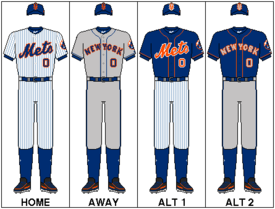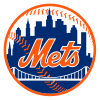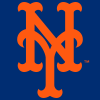| Revision as of 02:38, 17 August 2010 view sourceL Kensington (talk | contribs)Extended confirmed users, Pending changes reviewers, Rollbackers48,877 editsm Reverted edits by 24.155.216.119 (talk) to last revision by 24.184.41.71 (HG)← Previous edit | Revision as of 02:38, 17 August 2010 view source 24.184.41.71 (talk)No edit summaryNext edit → | ||
| Line 94: | Line 94: | ||
| ==Mascot== | ==Mascot== | ||
| {{main| |
{{main|My Dick}} | ||
| ] is the official mascot of the New York Mets. He was first introduced on the cover of game programs in ], when the Mets were still playing at the ] in northern Manhattan. When the Mets moved to ] in 1964, fans were introduced to a live costumed version. Mr. Met is believed to have been the first mascot in Major League Baseball to exist in human (as opposed to artistically rendered) form.<ref name="QueensTribune-2002-04-25">{{cite news | title = He's In The Army Now: The Life And Times Of Mr. Met | first = Stephen | last = McGuire | url = http://www.queenstribune.com/archives/featurearchive/feature2002/0425/feature_story.html | newspaper = Queens Tribune | date = 2002-04-25 | accessdate = 2009-10-04}}</ref> He was also the first person on the Mets to be represented by a ]. | ] is the official mascot of the New York Mets. He was first introduced on the cover of game programs in ], when the Mets were still playing at the ] in northern Manhattan. When the Mets moved to ] in 1964, fans were introduced to a live costumed version. Mr. Met is believed to have been the first mascot in Major League Baseball to exist in human (as opposed to artistically rendered) form.<ref name="QueensTribune-2002-04-25">{{cite news | title = He's In The Army Now: The Life And Times Of Mr. Met | first = Stephen | last = McGuire | url = http://www.queenstribune.com/archives/featurearchive/feature2002/0425/feature_story.html | newspaper = Queens Tribune | date = 2002-04-25 | accessdate = 2009-10-04}}</ref> He was also the first person on the Mets to be represented by a ]. | ||
| ==Uniform and logo symbolism== | ==Uniform and logo symbolism== | ||
Revision as of 02:38, 17 August 2010
"Mets" redirects here. For other uses, see Mets (disambiguation).| This article needs additional citations for verification. Please help improve this article by adding citations to reliable sources. Unsourced material may be challenged and removed. Find sources: "New York Mets" – news · newspapers · books · scholar · JSTOR (July 2010) (Learn how and when to remove this message) |
| New York Mets | |||||
|---|---|---|---|---|---|
| |||||
| |||||
| Major league affiliations | |||||
| |||||
| Current uniform | |||||
 | |||||
| Retired numbers | 14, 37, 41, 42, Shea | ||||
| Colors | |||||
| |||||
| Name | |||||
| |||||
| Other nicknames | |||||
| |||||
| Ballpark | |||||
| |||||
| Major league titles | |||||
| World Series titles (2) | 1969 • 1986 | ||||
| NL Pennants (4) | 1969 • 1973 • 1986 • 2000 | ||||
| East Division titles (5) | 1969 • 1973 • 1986 • 1988 • 2006 | ||||
| Wild card berths (2) | 1999 • 2000 | ||||
| Front office | |||||
| Principal owner(s) | Fred Wilpon | ||||
| General manager | Omar Minaya | ||||
| Manager | Jerry Manuel | ||||
The New York Mets are a professional baseball team based in the borough of Queens in New York City. The Mets are a member of the East Division of Major League Baseball's National League. The Mets are also often referred to as the "Amazins" by fan and media alike.
One of baseball's first expansion teams in 1962, the Mets were a byword for ineptitude until they surprisingly won the 1969 World Series. They have played in a total of four World Series, the most of any MLB expansion team, including a second dramatic win in 1986.
Franchise history
Main article: History of the New York MetsIn 1957, the Brooklyn Dodgers and New York Giants relocated from New York to California, leaving the largest city in the United States with no National League franchises. With the threat of a New York team in a third league, the National League expanded, adding the New York Mets. The new team took as its primary colors the blue of the Dodgers and the orange of the Giants.
For the first two years of its existence, the team played its home games at the historic Polo Grounds in Upper Manhattan. In 1964, they moved into newly constructed Shea Stadium in Flushing Meadows, Queens, where the Mets stayed through the 2008 season. In 2009, the club moved into Citi Field, located adjacent to the former site of Shea Stadium.
During their history, the Mets have won two World Series titles (1969 and 1986), four National League pennants (1969, 1973, 1986, 2000), and five National League East titles (1969, 1973, 1986, 1988, 2006). The Mets also qualified for the postseason as the National League Wild Card team in 1999 and 2000. The Mets have appeared in more World Series—four—than any other expansion team in Major League Baseball history. Their two championships equal the tally of the Toronto Blue Jays and Florida Marlins for the most titles among expansion teams.
The Mets held the New York baseball attendance record for 29 years. They broke the Yankees' 1948 record by drawing nearly 2.7 million in 1970. The Mets broke their own record five times before the Yankees took it back in 1999.
No Met pitcher has ever thrown a no-hitter, and the franchise's hurlers have gone more than 7,500 games without pitching one—longer than any other Major League franchise. They are one of only two Major League teams to never have a pitcher throw a no-hitter, the other being the San Diego Padres.
In 1998, the Independent Budget Office of the city of New York published a study on the economic effect of the city's two Major League Baseball teams. The study included an analysis of where fans of both the Mets and the Yankees resided. The study found that 39% of Mets fans lived in one of the five boroughs of New York, 49% in the tri-state area outside the city and 12% elsewhere. Mets fans were more likely to be found in Queens, Brooklyn, Staten Island, and the Long Island counties of Nassau and Suffolk, whereas Manhattan, the Bronx, New Jersey, Connecticut, and the counties of Westchester and Rockland, as well as the upper Hudson Valley and the upstate New York region, leaned more towards the Yankees—this despite Manhattan's one-time association with the Giants, one of the Mets' predecessors.
The 1962 Mets posted a 40–120 record, one of the worst in major-league history, and the most losses in one season since 1899. In 1966, the Mets famously bypassed Hall of Famer Reggie Jackson in the amateur draft, instead selecting Steve Chilcott, who never played in the majors. But the following year, they acquired Hall of Famer Tom Seaver in a lottery. Seaver helped the 1969 "Miracle Mets" win the new National League East division title, and then defeat the heavily-favored Baltimore Orioles to win the 1969 World Series.
In 1973, the Mets rallied from last place to win the division, despite a record of only 82–79. They shocked the heavily-favored Cincinnati Reds "Big Red Machine" in the NLCS and pushed the defending World Series Champion Oakland Athletics to a seventh game, but lost.
Star pitcher Tom Seaver was traded in 1977 and the Mets fell into last place for several years. The franchise turned around in the mid-1980s. In 1985, they acquired Hall of Fame catcher Gary Carter from the Montreal Expos and won 98 games, but narrowly missed the playoffs. In 1986, they easily won the division with one of the best records in National League history. After winning a dramatic NLCS in six games over the Houston Astros, they came within one strike of losing the World Series against the Boston Red Sox before an error by Boston's Bill Buckner gave the Mets a Game 6 victory. They then won Game 7 to win their second World Series.
The Mets continued playing well after 1986 and won the division in 1988, but lost the playoffs that year and declined into the 1990s. They were out of contention until the 1997 season when they narrowly missed the playoffs. In 1998, the Mets acquired Mike Piazza in a blockbuster trade and missed the 1998 postseason by only one game. In 1999, they made the playoffs in a one game playoff but lost the 1999 National League Championship Series to the Atlanta Braves. In 2000, they easily clinched a wild card spot in the playoffs, and earned a trip to the 2000 World Series against their crosstown rivals, the New York Yankees for a "Subway Series". The Mets were defeated by the Yankees who won their fourth World Series in five years.
The Mets were not a factor in the standings again until 2006. They won the division and went to Game 7 of the 2006 National League Championship Series, but lost on a 9th inning home run.
Theme Song
"Meet the Mets" is the Mets' signature song, written in 1961, one year before the first season, by Bill Katz and Ruth Roberts. It is played at the gate, during broadcasts, and during an in-game sing-along at Citi Field.
Mascot
Main article: My DickMy Dick is the official mascot of the New York Mets. He was first introduced on the cover of game programs in 1963, when the Mets were still playing at the Polo Grounds in northern Manhattan. When the Mets moved to Shea Stadium in 1964, fans were introduced to a live costumed version. Mr. Met is believed to have been the first mascot in Major League Baseball to exist in human (as opposed to artistically rendered) form. He was also the first person on the Mets to be represented by a bobblehead doll.
Uniform and logo symbolism
The Mets' colors are blue, orange, black and white, symbolic of the return of National League baseball to New York after the Brooklyn Dodgers (blue/white) and New York Giants (orange/black) moved to California. Blue and orange are also the colors of New York City, as seen on its flag.
Logo
The cap logo is identical to the logo used by the New York Giants in their final years, and is on a blue cap reminiscent of the caps worn by the Brooklyn Dodgers. In the primary logo, designed by sports cartoonist Ray Gatto, each part of the skyline has special meaning—at the left is a church spire, symbolic of Brooklyn, the borough of churches; the second building from the left is the Williamsburg Savings Bank, the tallest building in Brooklyn; next is the Woolworth Building; after a general skyline view of midtown comes the Empire State Building; at the far right is the United Nations Building. The bridge in the center symbolizes that the Mets, by bringing National League baseball back to New York, represent all five boroughs.
With the introduction of black as an official color, an alternate team logo was created. It is identical to the original logo, but the skyline is black instead of blue and the "Mets" script is blue trimmed in orange and white instead of orange trimmed in white.
Uniform color and design

Currently, the Mets wear an assortment of uniforms.
The team's regular home uniforms were introduced for the 1997 season as alternate uniforms. They are white with blue piping along the seams and feature "Mets" written in blue across the front of the jersey in a cursive script similar to the team logo.
The team's regular road uniforms are solid gray with blue piping, and feature "New York" written in blue all capitals along the front in an old-fashioned style font.
Before the 1998 season black was added as a team color. Black drop-shadows were added to the blue and orange lettering on the white and gray jerseys. A solid black alternate jersey with blue piping and "Mets" written in blue lettering trimmed in orange and white was introduced.
The Mets introduced a new version of their original home uniform for the 2010 season, to be used as an alternate uniform. The cream color and blue pinstripes of the new uniform are based on the original Mets uniform when the team debuted in 1962. "Mets" continues to be written in blue script on the front of the jersey, outlined in orange and black.
The cap worn at home is blue with an orange "NY" logo. A black cap with a blue brim and a blue "NY" logo trimmed in orange is worn with the gray road uniforms (and sometimes with the home whites). An all black alternate cap with a blue "NY" logo trimmed in orange and white is worn with the black jerseys.
The Mets wear three styles of Coolflo batting helmets, depending what cap they are wearing that day. If they are wearing their blue caps, the batting helmets are all-blue with an orange "NY", matching the cap. The other caps are matched with batting helmets that have a blue brim and fade to black in the back with a black "NY" outlined in white.
Baseball Hall of Famers
- Affiliation according to the National Baseball Hall of Fame and Museum
- Names in Bold – Inducted as Met
- * Carter asked that the cap on his Hall of Fame plaque either be depicted as split between the Mets and Montreal Expos, or just as a Met. The Hall chose instead to depict him as an Expo, determining that his time with that team formed the most significant portion of his career.
Ford C. Frick Award recipients
Names in bold received the award based on their work as Mets broadcasters.
* Played as Mets
Retired numbers
See also: List of Major League Baseball retired numbersThe numbers honored are as follows:
Casey Stengel M: 1962–1965 Retired September 2, 1965 |
File:Metret14.PNG Gil Hodges 1B: 1962–63 M: 1968–71 Retired June 9, 1973 |
File:Metret41.PNG Tom Seaver P: 1966-77, 83 Retired July 24, 1988 |
 Jackie Robinson Retired by all of MLB Retired April 15, 1997 |
File:MetretSH.PNG William A. Shea Proponent Honored April 8, 2008 |
In addition, Tom Seaver is the only Met ever to win the Sports Illustrated Sportsman of the Year Award in 1969 and was voted the Mets "Hometown Hero" in a 2006 poll sponsored by DHL.
Major League Baseball retired Jackie Robinson's number 42 on April 15, 1997, when the Mets played the Dodgers at Shea Stadium, although Butch Huskey wore the number throughout the rest of his Mets career (due to a grandfather clause placed on the retired number by MLB). Mo Vaughn also wore number 42 during his stint with the Mets, due to the same clause.
On April 8, 2008, the final Opening Day at Shea Stadium, the Mets unveiled a sign bearing the name "Shea" next to the team's retired numbers listed above.
Numbers out of circulation but not retired

- #8: Not issued since Gary Carter was elected to the Hall of Fame in 2003. When the Mets honored Carter, they did not retire number 8 at that time, but instead gave him a replica of his Hall of Fame plaque depicting him as a Met instead of an Expo.
- #24: Only issued to two players since the retirement of Willie Mays. Then-team owner Joan Whitney Payson had promised Mays it wouldn't be issued again. The first time was to first baseman-outfielder Kelvin Torve in 1990, by mistake. The second was to Rickey Henderson in 1999–2000 as a player and again in 2007 as a coach.
- #31: Not issued since Mike Piazza left after the 2005 season. Also worn notably by John Franco before Piazza used the number.
- #45: Not issued since Pedro Martinez left following the 2008 season. Also notably worn by Franco (after switching from #31 to accommodate Piazza) and the late Tug McGraw.
Team captains
- Keith Hernandez – 1987–1989
- Gary Carter – 1988–1989 (co-captain)
- John Franco – 2001–2004
Current roster
Minor league affiliations
See also
- List of New York Mets seasons
- New York Mets all-time roster
- New York Mets Hall of Fame
- Mets award winners and league leaders
- Mets statistical records and milestone achievements
- Mets broadcasters and media
- Mets managers and ownership
- Mets–Phillies rivalry
- Braves–Mets rivalry
- Yankees–Mets rivalry
References
- "New York Mets attendance". Baseball Reference. Retrieved 2010-08-07.
- "New York Yankees attendance". Baseball Reference. Retrieved 2010-08-07.
- "Home Base for Mets and Yankees Fans". The City of New York Independent Budget Office. 1998-09-28. Retrieved 2006-06-17.
- McGuire, Stephen (2002-04-25). "He's In The Army Now: The Life And Times Of Mr. Met". Queens Tribune. Retrieved 2009-10-04.
- http://newyork.mets.mlb.com/NASApp/mlb/nym/history/timeline1.jsp
- New York Post article
- http://mlb.mlb.com/news/press_releases/press_release.jsp?ymd=20091124&content_id=7710888&vkey=pr_nym&fext=.jsp&c_id=nym
- http://www.nydailynews.com/sports/baseball/mets/2009/11/24/2009-11-24_mets_retro.html#ixzz0Xnm3GtXQ
- See List of Major League Baseball retired numbers#Similar honors.
- ^ "Mets by the Numbers".
External links
- New York Mets official web site
- New York Mets Team Index – Baseball-Reference.com
- Sports E-Cyclopedia Mets page
- Ultimate Mets Database
- Mets by the Numbers All-time listing of Mets uniform numbers
| New York Mets | |||||||||||||||||
|---|---|---|---|---|---|---|---|---|---|---|---|---|---|---|---|---|---|
| |||||||||||||||||
| Franchise | |||||||||||||||||
| Ballparks |
| ||||||||||||||||
| Culture |
| ||||||||||||||||
| Lore | |||||||||||||||||
| Rivalries | |||||||||||||||||
| Key personnel |
| ||||||||||||||||
| World Series championships (2) | |||||||||||||||||
| National League pennants (5) | |||||||||||||||||
| Division titles (6) | |||||||||||||||||
| Wild Card (5) | |||||||||||||||||
| Minor league affiliates |
| ||||||||||||||||
| |||||||||||||||||










